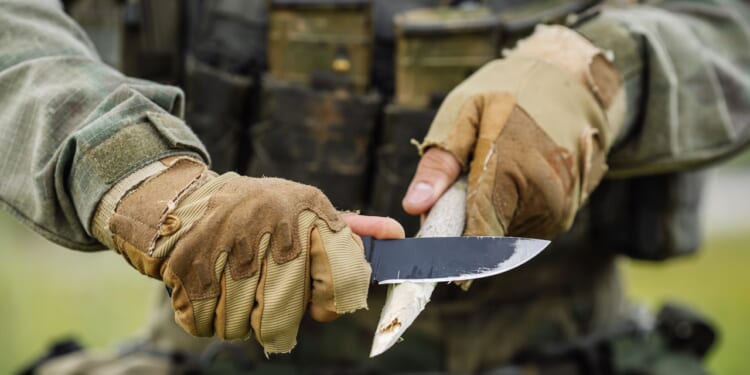In spite of advances in military technology, many servicemembers still carry knives, and expertise with them can mean the difference between life and death in close quarters.
Even in the era of high-tech jet fighters, drones, and other advanced weapons systems, sometimes you need a knife. The tried-and-true combat knife carried by American warfighters has evolved over the past century, and today, the different branches of the US Armed Forces carry various bladed weapons.
However, the Pentagon may be looking to put a new knife in the hands of warfighters, as the Defense Logistics Agency (DLA) has awarded an “indefinite-delivery contract” to the Virginia-based Atlantic Diving Supply, Inc., to supply a new bladed weapon for testing.
It follows an October contract solicitation issued by DLA Land and Maritime for a “Knife, Combat.” The contract specified an estimated quantity of 489 units, and was valued at up to $350,000. Although this would amount to more than $700 per knife, it is worth noting that this was the contract’s ceiling value, and the final version is likely to be worth far less.
“Final pricing may vary depending on delivery batches and configuration specifics as orders are placed,” The Defence Blog reported. It added that the Atlantic Diving Supply “provides a wide range of tactical gear, protective equipment, and weapons accessories to the military and federal agencies.”
The award notice didn’t identify the type of bladed weapon being supplied, nor which branch of the service would be receiving it. Given the small number that will be procured, these will likely be used in some form of field testing.
The US Military Has a Long History with Knives
Although US military personnel carried knives since the American Revolution, these were standard-issued items until World War I, when the M1917 Trench Knife was introduced. It featured a triangular 6-inch stiletto blade, developed specifically for close-quarters combat. As it was a single-purpose weapon, it was found to be nearly useless as a general tool.
It was superseded by the iconic M1918 Mark I, which featured a double-edged blade and a brass knuckle guard. That knife was also issued to US Army paratroopers during World War II, and it has more recently been in the pop culture spotlight after it was carried by the fictional main character in Darryl Dixon, a spinoff of AMC’s famed Walking Dead TV series.
During World War II, the M3 Fighting Knife was issued to soldiers who weren’t issued a bayonet. It was designed for hand-to-hand fighting, but proved to be well-suited as a utility tool. Around the same time, the United States Marine Corps adopted its famed KA-BAR Fighting Utility Knife. It featured a 7-inch clip-point blade with a stacked leather handle, and if the stories are to be believed, the name came from a trapper’s tale about a knife that could “kill a bear” (K-A-BAR).
Today, there are a variety of combat knives that warfighters can get a grip on, but among the most “standard” fighting knives are the Ontario MK 3 Navy Knife, a corrosion-resistant stainless steel knife with a 6-inch blade carried by US Navy SEALS, and the 8-inch OKC-3S bayonet, which the USMC developed to function as both a bayonet for the M16/M4 rifles and as a standalone combat and utility knife. The latter features serrations for sawing and a clip point, while its sheath features a built-in sharpener.
Given the effectiveness of the MK 3 and OKC-3S, it isn’t clear what the Atlantic Diving Supply knife could offer, but perhaps it is truly on the “cutting edge.”
About the Author: Peter Suciu
Peter Suciu has contributed over 3,200 published pieces to more than four dozen magazines and websites over a 30-year career in journalism. He regularly writes about military hardware, firearms history, cybersecurity, politics, and international affairs. Peter is also a contributing writer for Forbes and Clearance Jobs. He is based in Michigan. You can follow him on Twitter: @PeterSuciu. You can email the author: [email protected].
Image: Shutterstock / PRESSLAB.

















